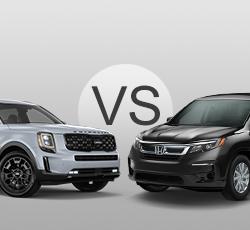2021 Honda Pilot vs Kia Telluride
The Honda Pilot and Kia Telluride offer full-size SUV options that stand out in the crowd. Both vehicles have plenty of space to comfortably transport passengers, while their powerful engines can easily handle even off-roading adventures with ease. With all these features packed into each car, buyers may find it difficult to choose between them - luckily this overview provides potential customers with a detailed comparison so they can make an informed decision about which model is better for them!
The Powertrain
Both the Honda Pilot and Kia Telluride have V6 powertrains that deliver excellent performance, but with a slight edge going to the larger engine in the Kia. The 3.5-liter unit of the Honda provides 280 horsepower and 262 pound-feet of torque while its counterpart in on offer from Toyota has an increased displacement at 3.8 liters offering 291 horses - although both boast identical levels of maximum twist force output! When it comes down to hauling hefty loads behind them, they are evenly matched, as they hold equal ratings for max tow capacity amounting up to 5 000 pounds each one can handle safely.
The Honda Pilot and Kia Telluride are both impressive vehicles when it comes to transmission technology. Both offer superior control, with the Pilot offering paddle shifters on its nine-speed automatic transmission while the Telluride offers a Sportmatic eight- speed system. But that's not all: drivers of these cars can also choose from different Intelligent Traction Management modes like snow, sand or mud - perfect for conquering tough terrain! Not only that but in select conditions you can even lock your AWD into place; making sure every adventure is as safe and secure as possible.
The Telluride offers four driver-friendly modes - Comfort, Eco, Sport and Smart – each tailor-made to give drivers the perfect ride experience. Whether looking for optimal efficiency or enhanced responsiveness on the road; rest assured that you'll be able to find your desired setting in this vehicle. The Pilot takes eco driving to a whole new level with its special features like an Eco Assist function and Idle Stop which shuts off your engine automatically when stopped at red lights!
Fuel efficiency can be a concern with larger vehicles. Many customers try to find models that are strong and powerful while having at least a decent fuel economy. The Pilot and Telluride do alright in this area. An AWD Pilot can earn an estimated 19/26 (city/highway) miles per gallon, and a FWD Pilot can earn up to 20/27 miles per gallon. FWD Tellurides can earn up to 20/26 miles per gallon, with AWD models not quite hitting that mark with an estimated 19/24 miles per gallon.
Drivability
Honda Pilot has multiple mechanisms that people will appreciate. First, it has Active Noise Cancellation to make the cabin more peaceful. Plus, nearly all of its trims have remote engine start. This can be useful when someone wants to warm up a vehicle in the winter or cool things down in the summer. All trims have something called Hill Start Assist, and this prevents the vehicle from rolling backwards after being stopped on a slope when facing uphill.
One useful component that can come with the Kia Telluride is a self-leveling rear suspension. It comes in handy when the rear of the vehicle is loaded down with heavy items. It can make the necessary adjustments so that the vehicle can be more balanced and drive more smoothly.
Taking its size into account, the Honda Pilot and Kia Telluride have comparable exterior measurements. With a length of 196.5 inches and width of 78.6 inches, both vehicles offer ample room for passengers in addition to solid stability on even terrain; however with the Telluride sitting just one inch higher off the ground than that of the Pilot's 7.3-inch height clearance value, it could be more suitable when traversing bumpier roads where an extra inch makes all difference!
The Honda Pilot and Kia Telluride provide plenty of legroom for passengers, with the only difference being around three inches between front rows. While taller individuals may want to opt into taking a seat in either vehicle's second row, anyone over five feet tall might find riding in the third row choppy waters - but no worries! That just leaves more room back there for children or smaller adults who won't mind having their knees close together while they enjoy the ride.
Cargo room can affect what people can do with their SUVs, as some customers might need the space for bikes, skis, or work equipment. In the Honda Pilot, there is around 17 cubic feet of space behind all of the seats. If those seats are folded down, cargo capacity increases to about 84 cubic feet. The Telluride has a little more room to accommodate cargo. It has a cargo area in the back that has a volume of approximately 21 cubic feet. There could be around 87 cubic feet of total space when all the rear seats have been lowered.
When comparing the technology packages offered in the Pilot and Telluride, the Telluride comes out as the winner. That's because it comes standard with an eight-inch touchscreen with smartphone compatibility, and it can have a 10.25-inch touchscreen with integrated navigation and a ten-speaker Harman Kardon audio system. The entry-level trim of the Pilot only has a five-inch LCD screen with Bluetooth. On all of the other trims, there are eight-inch touchscreens with Apple CarPlay and Android Auto. Navigation is available, as is a 10-speaker sound system.
However, this information doesn't tell the whole story as it relates to the technology package. The Honda can come with an in-vehicle intercom to improve communication, multi-zone audio so everyone can set their preferred volume, wireless charging, and Wi-Fi capability. Drivers could also set up their cabins with rear-seat entertainment systems that can play Blu-ray discs and support certain types of streaming.
The Kia Telluride offers a range of modern features for those wanting the latest in convenience. It has wireless charging, allowing drivers to keep their devices juiced up on longer trips. Plus its "Driver Talk" intercom provides easy communication between front and rear passengers while Quiet Mode helps ensure peace and quiet when desired by reducing volume levels at the back seats - ideal whether you're looking to get some rest or use your own device without interruption!
To avoid overpaying on a new car, shop prices online first. Get up front pricing before you walk into a dealership. We recommend the following free services; Car Clearance Deals, NADAguides, CarsDirect & & Motortrend.
These free services will offer you the lowest prices and supply you with multiple competing price quotes. You will know the best price before you visit the dealer.
Safety
There are several mechanisms in both vehicles that make them safer. Of course, they have multiple air bags, sturdy and solid frames, and three-point seatbelts that can hopefully keep everyone in place in the event of an accident. Beyond these standard components, there are driver-assist technologies that can actively work to monitor the situation, warn drivers about problems, and potentially take corrective measures.
The Pilot has a Honda Sensing suite of safety features. It consists of a few different types of monitors and mitigation systems that can prevent dangerous situations. For example, these SUVs can warn drivers when they're approaching other vehicles too quickly or drifting out of their lanes. If so, they can slow themselves down and/or correct their steering. Automatic high beams and adaptive cruise control are also standard. Most, but not all, of the trims have blind spot and rear cross traffic monitoring.
Likewise, the Kia Telluride has many driver-assist systems that people can have rely on. The Telluride can sense potential forward collisions, and it will know when it's drifting out of a lane. In certain situations, it can alert drivers and help them avoid certain types of incidents. Notably, blind spot and rear cross-traffic alert are both standard. The Telluride has more systems as well, including driver attention warning, parking distance warning, and a system that lets passengers know when it's safe to open up their doors and exit the vehicle.
Automatic high beams are only available on the highest trim of the Telluride, unlike what the Pilot offers. However, the Telluride's highest trim has a 360-degree camera view that could be useful. Every trim has adaptive cruise control, too.
Which Has the Best Value?
With the Honda, you can choose from seven different trims to treat yourself with that perfect car. Starting at $32,550 for the LX and going up all the way to a luxurious Black Edition priced at over 50K - there's something in everyone’s budget! In between these two extremes lies an EX ($35,230), along with five other options like an EX-L($38 660) or Touring ($43 220). On one hand if luxury isn't your main concern then consider another option; The Telluride is full of choices but only four models being offered: beginning with its most affordable trim costing just over 30K followed by three others capping off at nearly 42 and half thousand dollars – could it be what you're looking for?
With the Telluride, you get more bang for your buck! The base models of these two trims are competitively priced, but if you're looking to save some cash on something a little fancier then there's no beating Kia - their higher end offerings come with considerable savings compared to that of the Pilot.
The Honda Pilot and Kia Telluride are similar but have a few crucial differences. Notably, the base model of the Honda does not come with an expansive touchscreen or Apple CarPlay/Android Auto that comes standard in its competitor. While it makes up for this lack by offering tri-zone climate control, you'll only find manual air conditioning on the Kia's starting variant; as well as synthetic leather seating instead of cloth found in other trims.
On the mid-level trims of the Pilot and the Telluride, there are improvements in both the quality and quantity of the features. Things like heated front seats, moonroofs, power tailgates, and auto-dimming rearview mirrors become standard. Keep in mind that the low- to mid-level trims of the Honda Pilot have room for eight, while there could be eight- or seven-passenger seating configurations in the mid-level trims of the Telluride.
The Telluride is for the driver looking to add some sporty sophistication and style with stainless steel pedals, heated front seats, customizable interior lighting. The top two trims of the Pilot take it up a notch by offering heated second-row seating as standard — perfect for those long family trips! It also boasts panoramic moonroofs, captain's chairs with perforated leather upholstery that truly help make your ride luxurious.
Which is Better?
The Honda Pilot is the classic among crossovers, providing plenty of comfort in a spacious cabin. Even with its age it offers superior technology like power tailgates and LED fog lights - not to mention an available rear-seat entertainment system! And while some features can't be found here as they are on other models, such as 360 degree camera systems or head up displays – true lovers will still appreciate what this trusty crossover has to offer.
The Telluride has quickly become renowned for its robustness, making it a go-to vehicle choice. It boasts an impressive cabin, with more legroom than the Pilot and cutting-edge infotainment technology to match. The synthetic leather seats are given added opulence courtesy of optional LED lighting - creating a stunningly luxurious look that stands out from other cars on the road!
With the Pilot and Telluride, choosing a vehicle that suits your needs comes down to personal preference. Each offers competitive performance levels, but if you're looking for something with more modern flair then the stylish exterior of the Telluride is hard to beat. While it may look ordinary from afar, closer inspection reveals an interior packed full of family-friendly entertainment features – making every drive in your Honda Pilot just as enjoyable as its sleek counterpart.

Get up to 4 local dealers to compete for your business by offering free, competitive pricing. Know before you go to the dealer.
Every dealer offers a secret price. Find yours here.
• 2021 Honda Pilot VS Acura MDX
• 2021 Honda Pilot VS GMC Acadia
• 2021 Honda Pilot VS Hyundai Palisade
• 2021 Honda Pilot VS Kia Sorento
• 2021 Honda Pilot VS Kia Telluride
• 2021 Honda Pilot VS Toyota 4Runner
• 2021 Honda Pilot VS Toyota Highlander
• 2021 Honda Pilot VS Volkswagen Atlas


